
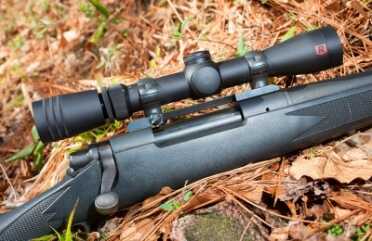
The Redfield Revolution 2-7×33 mm retails for around $200 and in testing its performance was comparable to riflescopes that cost much more.
Redfield
www.redfield.com
It wasn’t long ago that Vegas would have given you better chances of capturing Yeti and domesticating him into a beer-fetching manservant than finding a decent American-made riflescope for around $200. The Redfield Revolution 2-7×33 mm beats the odds, but its performance proved far from flawless after finding the scope’s mechanical zero proved an elusive, time-draining challenge during testing.
Most riflescopes are sold with their reticles near that sweet spot, but it’s always important to verify before mounting. Billed as having an adjustment range of 65 moa for both elevation and windage, in ¼ moa increments per click, both knobs were carefully turned until they stopped. Then the number of clicks were counted as the knobs were turned the opposite direction to reach the other stop (remember, on any scope don’t try to force past either firm stop or you can damage the optic). Out of the box, the Revolution provided 329 clicks in elevation and 162 in windage, or 82.5 moa and 40.5 moa, respectively. The latter figure was 24.5 moa less than advertised.
However, some experts at Leupold advise working those knobs on long-range scopes extensively before mounting to “lap in” the internal mechanics. There are those at Nikon who politely disagree, but it’s Leupold that purchased Redfield in 2008 to resurrect a name that has been familiar to shooters since 1909, so the recounts began. The second time through, elevation was holding steady at 329, but windage had upped itself to 164 and the stop seemed mushy. Things weren’t forced, but the third trip around windage improved to 175 clicks and an hour later it was holding steady at 321, or 80.25 moa.
No, this isn’t a scope designed for precision work at 1,000 meters, but during a long-range seminar at Gunsite the wisdom of doing this became obvious. First, you become intimately acquainted with exactly how much pressure it takes to turn the knobs (a huge advantage when you’re prone and trying to hit a target at 800 meters). Give it a try and you’ll be surprised how easily you can miscount when you first start, but after a few passes those inadvertent double clicks disappear.
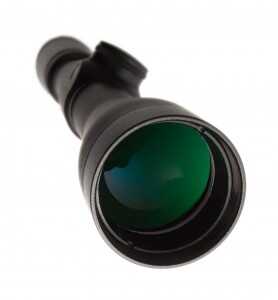
The multi-coated objective lens, which measures only 33 mm, worked well during testing and even in fading light provided good contrast in its images.
It’s also important to have the reticle as close to mechanical zero as possible prior to mounting, otherwise you cannot take advantage of the optic’s full adjustment range. The easy way to think of this internal geometry is to consider the view through a riflescope. It’s a circle with the crosshair in middle. If it is aligned precisely with the optic’s mechanical zero, then a riflescope with 100 moa adjustment will have 50 moa of elevation adjustment both above and below. Now, envision a dot to the left of the crosshair and imagine a line through it, parallel to the centered vertical stadia. If you were to measure the length of that line between its intersection points with the circle it is shorter (less adjustment range) than the centered stadia line. That’s about the easiest way to visualize why finding mechanical center allows you to harness a scope’s full potential.
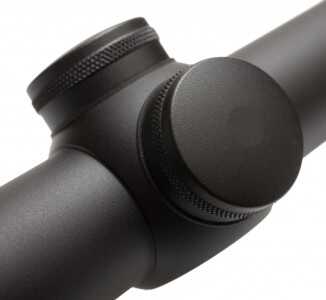
Protected by metal caps, don’t expect to be dialing for elevation in the field easily. With this magnification and Accu-Range reticle, it shouldn’t be much of a concern, though.
This riflescope wasn’t designed for dialing in distant-shot dope, but it’s a good habit to find that mechanical zero and to write down the information in a notebook. The world is not perfect, nor are mounting, mounts, loads or rifles, so regardless of your efforts things will not align magically and adjustments will be needed as you sight in. If you also enter that data in your notebook, re-mounting the riflescope on another gun will not require yet another trip through click-counting purgatory.
In this case, the windage adjustment knob was cranked until it stopped and 160 clicks (321/2=160.5, and I rounded down because there are no half clicks) were added. For elevation, again beginning at that knob’s stop, it was turned 164 clicks (329/2, again rounded). This particular riflescope was now close to mechanical zero and ready to mount. Odds are good, however, these zero values will vary even within the same scope models.
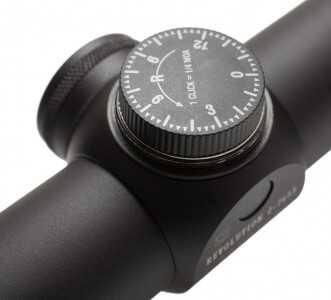
When trying to find the scope’s mechanical zero, windage adustment didn’t seem to live up to the 65 moa billing, at first. After some work, though, it seemed to “lap in.”
In regard to function, the adjustment knobs on this scope are protected by sturdy aluminum caps, not plastic, and texturing helps ensure grip when dialing in (no tools or coins are required). They are, however, small enough that turning them may be a tough task in inclement weather or when wearing gloves. Like most hunting or self-defense optics, simply adjust for your pet load, replace the caps and forget about them. Feedback with each click is positive and improved with use.
More than a few riflescopes’ claimed fog-proof properties surrender unconditionally when leaving a warm tent or house and entering sub-freezing temperatures. The Redfield Revolution, however, did not fog at all when it changed locations from 68-degree warmth to pose for pictures in a 28-degree snowstorm. In fact, it didn’t fog after an hour in the light snow, or upon its return to office warmth. The 1-inch, aluminum main tube’s nitrogen filling makes this an optic upon which you can rely in poor conditions.
Magnification was the second concern, although it’s not a deal-breaker. Listed as a 2-7X, Redfield’s specification chart more accurately depicts it as a 2.5-6.5X. The loss in zoom range isn’t really of much concern, although it is worth noting. There is no bump to speed magnification changes on the power ring, although the large indent, coupled with texturing on the knob, made getting a solid grip easy.

Although billed as a 2-7 power riflescope, the details on the Redfield website show it to truly be 2.5-6.5X.
At 11.1 ounces the scope doesn’t add much heft to a rifle, and MSRP is listed at $224.99 or $239.99, depending on reticle. Expect street prices to be a little less, somewhere around $200.
Field of view at 100 yards at 2X (really 2.5X) is listed as 43.2 feet. Dialed up to 7X (6.5X) it is 17.3 feet. Even at dusk the 33 mm objective lens collected light efficiently and the image was bright. It’s not high-end-optic crisp, but there didn’t seem to be any color distortion toward the sides and small details on distant objects could be spotted with ease.
The least-expensive version comes with a 4-Plex Reticle, a familiar configuration for most hunters. The stadia lines are thicker on all four sides, then thin toward the center. The idea is the bolder outside lines force your attention toward the thinner crosshair, where you can deliver a precise shot.
The test model arrived with the Accu-Range Reticle, a drop-compensating version for multiple chamberings that is not complicated enough to require a math degree. Its configuration is similar to the 4-Plex, except a thin circle (which helps speed those fast shots at lower magnification) is centered around the crosshair.
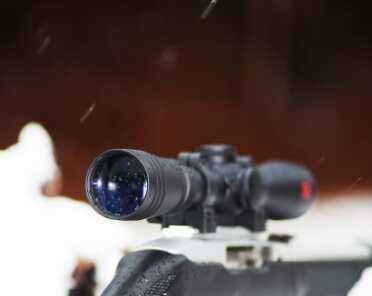
To test the fog-proof claim, the scope was taken out into a snowstorm. Despite leaving 68 degrees and spending an hour in the freezing temperatures, it did not fog, nor did it when taken back into the office.
Depending on the load, Redfield recommends either a 200- or 300-yard zero at the crosshair. Then, where the circle meets the vertical stadia is your first holdover point (the distance, of course, depends on bullet weight and chambering). Below that, a small dot is your next hold and where the stadia widens toward the bottom is the last. For example, for a .270 WSM cartridge with a 130-grain bullet (muzzle velocity of 3,275 fps) with a 300-yard zero, has a 400-yard holdover point where the circle intersects the vertical stadia below the crosshair. Hold on the dot below for 500. Here’s a closer look at how it works for different cartridges.
To test the waterproof claim, the riflescope was submersed for an hour, escaping unharmed. Add how fast the snow hit the optic and instantly melted on it during the fog-proof test, and we’re confident the Redfield Revolution 2-7×33 mm does not leak.
A Redfield logo on the right side isn’t so large and gaudy that it ruins the scope’s matte-black finish. This is, after all, an optic primarily designed for hunting. The same modest approach is true for the “R” on the left.
In shooting sessions, the scope proved its adjustments were rock solid and repeatable. After sighting in, the optic was turned one MOA at a time, to the left, down, to the right and back up to original settings. Each three-shot group moved consistently, stayed on target and the last group confirmed it returned to the original zero with no undue heartache. That’s the primary function of a riflescope and the Redfield Revolution delivered.
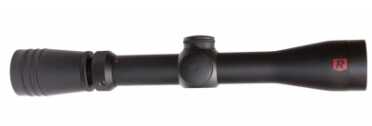
With a 1-inch, nitrogen-filled main tube made of aluminum, the Redfield Revolution 2-7×33 mm should provide years of rugged use.
Eye relief is 3.7 to 4.2 inches. Exit pupil is 13.2 to 5.1, and best of all, the Revolution comes with Redfield’s lifetime warranty. That means if the optic goes down, even if you don’t have the receipt or are not the original owner, it goes back to Oregon to be fixed.
Despite the fact testing got off to a rocky start, there’s a lot to like in the Redfield Revolution 2-7×33 mm, especially the fact that this American-made optic performs well without breaking the bank.


this is a fine american made rifle scope with a crisp bright view , excellent eye relief and good FOV. all this at a moderate price point. this is a basic hunting scope and though they made the windage and elevation adjustments finger adjustable i suspect on this scope the turret caps won’t be removed very much after sighting in. i’ve used this scope for two seasons now and had no problems . the size is perfect as is the zoom range.
Your experience is similar to mine. I’ve got a Revolution 3-9×50 sitting on a Mosin. For the money, this scope’s hard to beat, and made in USA, too, which is a major plus. Seriously, if I can’t get it done with a scope like this, then I deserve to go hungry.
“It’s also important to have the reticle as close to mechanical zero as possible prior to mounting, otherwise you cannot take advantage of the optic’s full adjustment range.”
I think you have been breathing too much gunpowder smoke. Unless you have adjustable bases for elevation (Leupold and Burris has windage adjustable) The cross hair is going to end up in the same position once you zero the rifle no matter where you turn the turrets or not. If what you were saying were true there would be no need for bases that have 20, 30 40 and whatever else MOA built into them. I really do wish you fellows had the smarts you think you do before you write an article.
But there are differing heights of rings or in the case of Talley, rings/bases.
If you were moving the scope from a rifle with low rings to one with high rings, you may need the adjustment ability.
I’ve got one mounted on a modern sporting rifle, accu-plex reticle. It’s clear, was affordable when purchased and does the job well.
The included guide gives pretty good results on the MSR with zeroing and then using the various aiming points in the reticle. No complaints, but like all optics…different scopes for different folks!